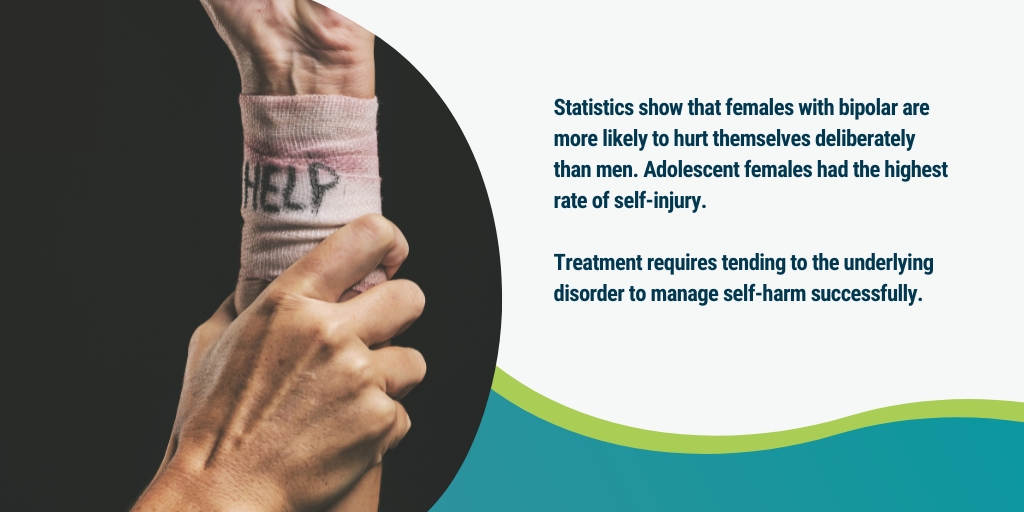
Self-harm occurs when someone purposefully hurts themselves. It is a maladaptive behavior for coping with pain, anger, stress, or sadness. People cut, burn, bite, hit, or carve themselves to alleviate their suffering. The action can be mild or severe, sometimes becoming a fatal incident.
Mild forms of self-harm are known as non-suicidal self-injury (NSSI). In this form of deliberate harming, the individual does not intend to inflict lethal harm to themself. However, the repetitive nature of this destructive habit and the brain’s addictive and tolerant nature of the pain threshold pushes the person into more fatal practices.
Some psychiatric disorders increase a person’s susceptibility to self-injury. The symptoms of these disorders feel intolerable, pushing the person to injure their bodies deliberately for some relief and calm at the height of their emotional tension. Unfortunately, the release is temporary. Shame and guilt usually accompany it, fueling the underlying distress.
The downward trajectory of the high leads to another attempt at freedom from the physical and mental anguish, creating a vicious cycle of continuous self-injury. Self-harm can become lethal. It also worsens a person’s mental condition by feeding into their insecurities, worries, pain, and fears.
Some of the top psychiatric disorders that increase a person’s risk of self-injury include:
Bipolar Disorder
According to research, about 50% of people with bipolar disorder exhibit self-harm symptoms. Variation in symptoms manifestation and severity accounts for the lack of self-harm for some people. Some people experience severe manic episodes accompanied by psychosis, which feel uncontrollable. On the other hand, some people experience mild manic episodes with non-psychotic symptoms.
Studies also show that bipolar patients are more likely to self-injure during the mixed state of the disorder, where both the manic and depressive symptoms manifest. Before the mania transitions into depression, a person with bipolar hangs in limbo with intense emotions, tension, uncontrollable racing thoughts, and sleeplessness, which push them into self-injury to calm down.
The rate of suicidal tendencies is much higher during the mixed state than during the mania and depressive phase. Helplessness from the lingering symptoms pushes people beyond their capacity to tolerate the manifestation of the disorder. Unfortunately, what begins as non-suicidal self-injury often morphs into serious injuries.
Statistics show that females with bipolar are more likely to hurt themselves deliberately than men. Adolescent females had the highest rate of self-injury. Treatment requires tending to the underlying disorder to manage self-harm successfully.

Borderline Personality Disorder
Self-harm and suicidal tendencies and attempts are part of the diagnosis criteria for borderline personality disorder (BPD). Research shows that 50% to 80% of borderline personality disorder cases exhibit self-injury. About 40% of these incidences become severe.
Typical forms of self-harm include cutting, bruising, head banging, and biting. People with borderline personality disorder self-injure to cope with their negative states, reduce stress, or express their emotions. Elevated negative emotion is a characteristic of borderline personality disorder.
Symptoms of BPD include:
- Fear of abandonment – characterized by intense worry and anger over perceived or real neglect or rejection.
- Chaotic, erratic, and extreme relationships – abrupt mistrust and devaluing of loved ones create dramatic and intense emotions.
- Unstable self-image – a person with BDP feels bad or inadequate. They often self-sabotage, quit jobs, and change friendships, opinions, and goals on a whim because of their negativity.
- Instantaneous mood changes – switching through negative emotions like anger, worry, sadness, hate, and sometimes love.
- Lingering emptiness – accompanied by self-hate, boredom, unfulfillment, and despair.
- Impulsive maladaptive behavior – like substance abuse, gambling, promiscuity, reckless driving, or binge eating.
The constant negativity encourages self-harming because the person feels undeserving, unqualified, or a fake. The self-loathing drives them to self-destructive behavior. Dejected from rejection, abandonment, or disappointment also pushes them to deliberate body harming.
Depression
The depressive mood comes with an overwhelmingly negative attitude and perception of life. It takes away the joy and hope of being alive. The lingering feeling of despair and helplessness, persistent negative thinking, suicidal ideation and attempts, and self-harm drive the depressed individual toward destructive behavior to cope.
Self-harm functions as an escape from the mental anguish and emotional distress experienced by the person. However, each injury provides temporary relief and can push the person to extreme degrees with each subsequent opportunity.
Depressed women, youth, and adolescents are more likely to indulge in non-suicidal self-injury and attempt suicide than men. However, men have a higher likelihood of committing suicide successfully. The variation in symptom manifestation has more to do with the gender expression of depression.
Men are less likely to talk out their feelings. Nurture conditions them to bottle up their emotions and thoughts, triggering a phenomenon known as the rebound effect. The suppressed feelings and thoughts linger in your mind and manifest in unhealthy ways. Overall, depressed individuals are 15% more likely to commit suicide than their healthy counterparts.
Substance Use
Substance use disorder is a maladaptive habit in many psychiatric conditions. It is no surprise that it pushes people to self-harm. Substances are psychoactive. They provide temporary relief by activating the reward pathway, which evokes feelings of happiness, satisfaction, calmness, and rest.
The reward pathway works by inhibiting the stress response, which arouses anxiety and depressive mood. Alcohol, drugs, pain medication, tobacco, and so forth stimulate an intense chemical rush, producing potent euphoric levels, temporarily masking mental anguish, emotional distress, and physical pain.
Unfortunately, the brain adapts to these high levels, numbing its response to natural stimulants of the reward pathway. It also learns to tolerate and encourages you to use substances leading to addiction. Furthermore, the intense positive state wears down to an extremely low negative state – below the normal threshold. The brain also produces horrible withdrawal symptoms in the absence of stimulation.
The negative effects push addicts into self-injury to release the pent-up mental tension, severe depression, and anguish. The relief is also short-lived, leaving the person in a self-destructive cycle. In addition to the effects of addiction, alcohol, drugs, and prescription medication diminishes a person’s judgment and impulse control, increasing their vulnerability to fatal injuries.
Seeking Help for Your Mental Health
At My Psychiatrist, we understand that self-injury can be an expression of intense emotional distress and a way to cope with unbearable feelings. We know it’s not easy to talk about – but if you or someone you care about is struggling with self-harm, please reach out for professional help. Our team is dedicated to providing a safe and supportive environment where healing can begin. Contact My Psychiatrist today to book an appointment with one of our board-certified mental health providers.

IMPORTANT: If you or someone you know is in crisis, please call the Suicide and Crisis Lifeline at 988. They are available for free, 24 hours a day, seven days a week.
